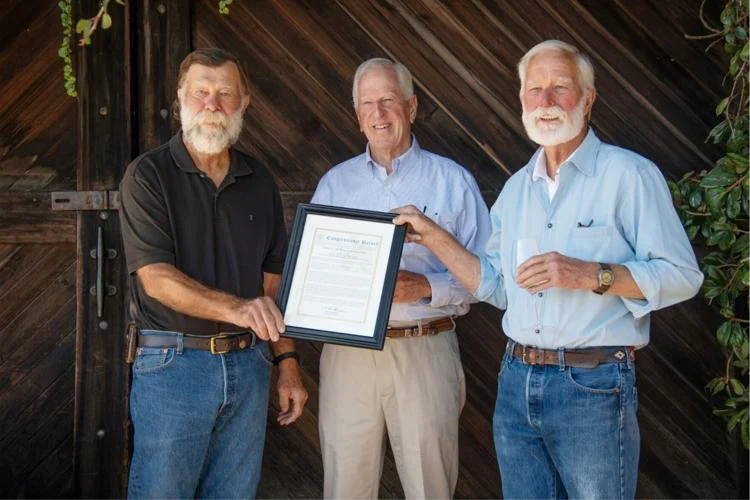Originally published in the St. Helena Star
When was your winery founded?
“I founded Smith-Madrone in 1971.”
Why did you choose to be in the Spring Mountain District American Viticultural Area (AVA)?
“As a grad student in the viticulture and enology program at UC Davis, I embraced the belief that there are two unassailable tenets of wine. The first is that only great wine can come from the very best grapes. Secondly, as Virgil wrote in 17 BC, ‘Bacchus amat colles.’ Bacchus loves the hills, hence this quest of mine drove me to the top of Spring Mountain. Our estate is dramatically situated, not only at 1,900 feet elevation but also with slopes approaching 34% in steepness and exposures to all four points of the compass.”
Who is owner? Who is winemaker? Who is vineyard manager?
“The winery is owned by a partnership. The winemaker is Charles Smith; associate winemaker is François Bugué; general manager/partner and vineyard manager is Stuart Smith.”
How many acres do you farm in the Spring Mountain District AVA? How does that break down into types of varietals/acre?
“38.5 acres.”
Do you farm sustainably/organically/biodynamically?
“We farm sustainably and may have coined the term ‘fire-safe farming.’”
Please describe your vineyards: soil; exposure; narrow spacing; type of trellising; irrigation/dry-farmed, etc.
“Our vineyards sit at elevations between 1,300 and 2,000 feet, on steep slopes which range up to 34%. We initially planted Chardonnay, Riesling and Cabernet Sauvignon in 1972. Cabernet Franc and Merlot were added in 1998. Petite Verdot was added in 2007.
“I chose specific slopes with different exposures for specific varietals when planting the vineyards: eastern exposure for Riesling, southern and western exposures across flat stretches for the Cabernet Sauvignon and the coolest north-facing slopes for the Chardonnay.
“The soils are mostly deep-red Aiken Stoney Clay loam, part of the Aiken, Kidd, Forward complex of soils which are volcanic-based, well-drained and deep for mountain soils. The underlying geology is the Franciscan Assemblage, unique to the California coastal ranges, which includes altered mafic volcanic rocks, deep-sea radiolarian cherts, sandstones, limestones, serpentines, shales and high-pressure metamorphic rocks, all of them faulted and mixed in a seemingly chaotic manner as a result of tectonic plate activity. The soils are rocky, with some rocks as large as small cars. We see lots of wildlife on our ranch, whether coyotes, black bears, skunks, wild turkeys, bobcats and foxes.”
Wineries today try to differentiate the visitor experience. What’s unique about visiting your winery/tasting room?
“When you come for a tour and tasting, you’re always greeted either by one of the Smiths or François and the tasting takes place in our winery. You will spend your visit with one of us that has close to a half-century of experience and we will answer any and all of your questions. Weather permitting, you will likely stroll out into the Chardonnay and Cabernet vineyards surrounding the building or up to a scenic lawn with dramatic views in all directions up and down the valley floor and over to Howell Mountain and the eastern flank of the valley. The tasting is an extremely personal experience where we share not only our history but also the nuances of all of the wines we make.”
What might surprise people to learn about you/your winery/your operation?
“How small we are (we only produce around 3,300 cases a year). We’re an all-estate fruit operation; all of our wines are made entirely from our estate vineyards.
“How we decided on our name: Smith to honor our family and the hard work behind establishing the vineyard and winery, and Madrone to honor the prevalent tree on the ranch.
“We are pioneers and longtime practitioners of dry farming and non-till: this approach is possible in mountain terroirs, if the right spacing and rootstocks are used. With climate change we cannot be fanatical about this and realize that in some drought years drip irrigation may be needed. Our goal is to use as little irrigation as is possible. We have one block of Cabernet Sauvignon that was planted in 1974 on AXR#1 and hasn’t had a drop of water from us since the day we planted it.”
What is special about the Spring Mountain District AVA, in your opinion? Is it misunderstood? What do you wish visitors knew about it which perhaps they don’t?
“It’s special because it’s so spectacularly beautiful. As you drive up Spring Mountain Road at every turn the views are different, whether a vista over the valley at a distance or forest or vines. Nothing is boring on Spring Mountain! Nothing is flat, predictable or easy. Farming on these steep slopes is a challenge and calls for a certain kind of personality. There’s an overall rustic vibe on Spring Mountain, not to diminish the elegance and complexity of the wines everyone makes. There’s also quite a history here of pioneers and Native Americans who lived here in ‘older’ times.”
What’s your favorite place in St. Helena to eat, drink or relax?
“Villa Corona, Market and Press — can’t choose just one!”
Learn more about Smith-Madrone here
(This is the latest in a series of Q&A articles highlighting winemakers and grapegrowers in the St. Helena area.)

